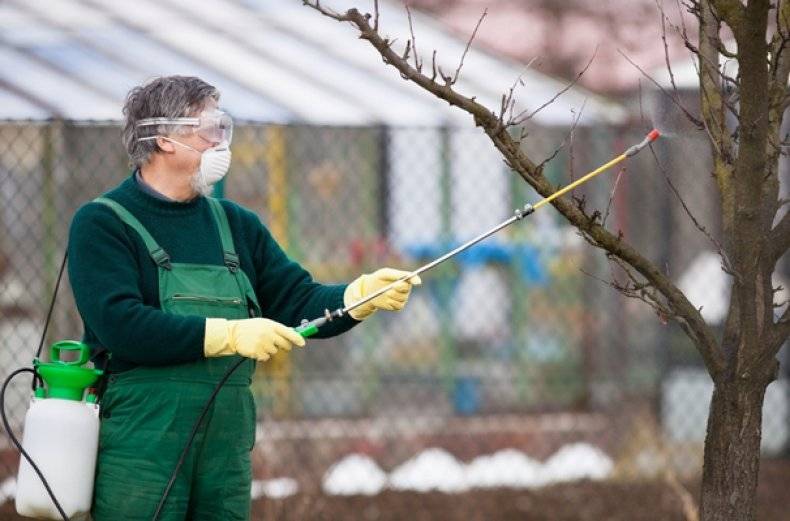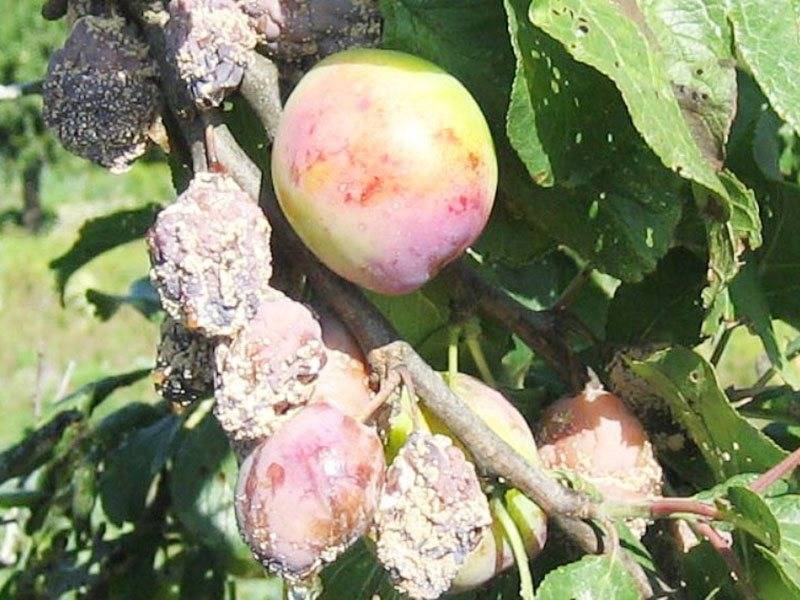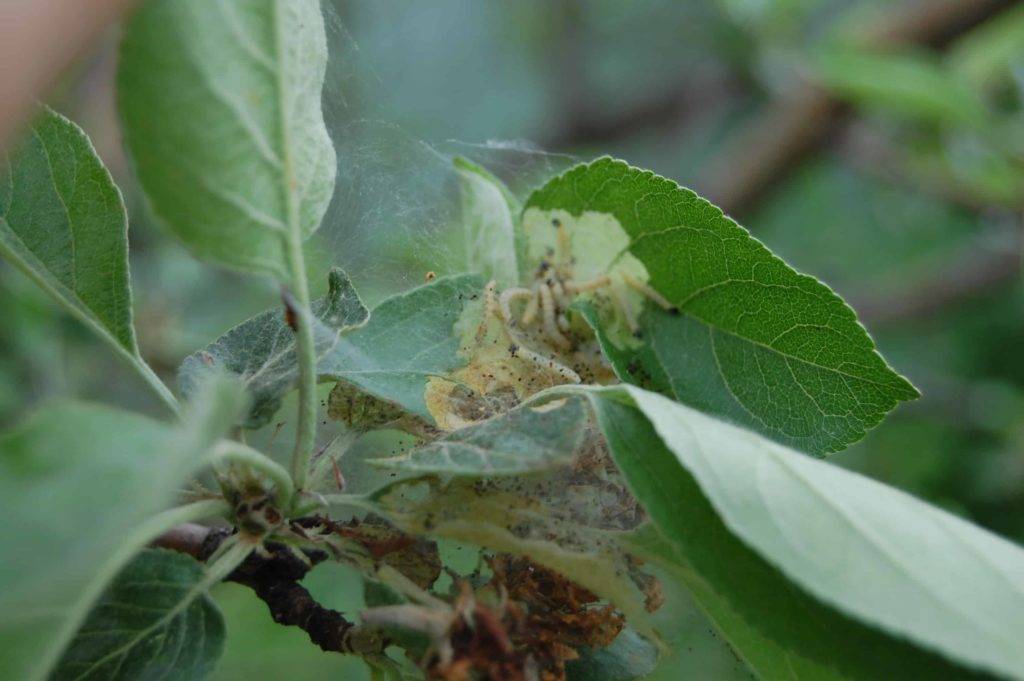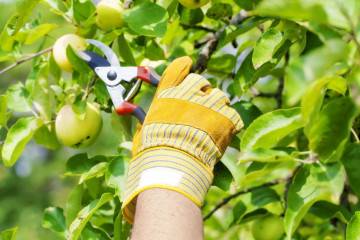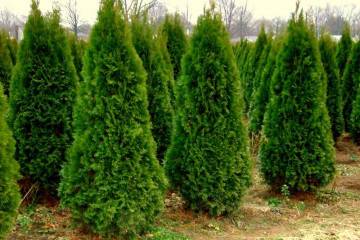Spraying fruit trees in spring before and after flowering
Content:
- Spraying fruit trees in spring
- Why spray in the spring
- Bacterial burn of fruit trees and measures to combat it
- Scab on fruit trees and preventive measures
- When to spray trees in spring
- Is it possible to spray trees during flowering
- How to spray trees after flowering
- Spraying with urea trees and shrubs in spring
- When can you spray fruit trees with copper sulfate
- Fruit tree pests and control
The yield of fruit trees depends on many factors. Spring processing of plants has a great impact on their health and fruit quality. Spraying of fruit trees in the spring must be carried out regardless of whether there were pests on the trees last season or not. The procedure is necessary for the prevention of various diseases and parasites. If you do not do it, then the trees may die.
Spraying fruit trees in spring
The procedure serves as the prevention of dangerous diseases, prevents the appearance of pests. With its help, plants are prepared for vegetation, the formation and ripening of fruits. In the spring, pests are weakened, so the fight against them at this time is most effective.
Why spray in the spring
The new season for gardeners begins with the treatment of trees with a sprayer. Most of the worst enemies of fruit-bearing trees hide deep under the bark or in the soil under the roots. There they actively develop and, when warming, begin to attack plants.
Well done spraying:
- prevent the attack of pests;
- will provide reliable protection against diseases;
- will create favorable conditions for abundant flowering and a good harvest.
Pests appear with the first spring rays. They begin to attack plants intensively. As a result of their pernicious influence, trees weaken, shed flowers and fruits, give poor harvest and may even die. In the absence of proper care, even healthy seedlings begin to hurt.
Bacterial burn of fruit trees and measures to combat it
One of the most dangerous diseases is bacterial burn. It is an infectious disease that can cause irreparable harm. In case of a bacterial burn of fruit trees, measures to combat it should be taken immediately.
To combat the disease, plants are sprayed with preparations of scor, oxych or rovral. The procedure is repeated 5 times until the end of flowering.
Scab on fruit trees and preventive measures
Dangerous infectious disease scab is one of the most common problems of fruit crops. It develops under the influence of bacteria and pathogenic fungi. Apples and pears are susceptible to it. With its development, the surface of shoots, fruits, leaves is deformed. Warts, dark spots and ulcers appear on their surface.
Preventive measures for scab will protect fruit crops from disease. In early spring, thinning and sanitary pruning of the crown is carried out. Before the start of sap flow, the plants are treated with a solution of nitrafen emulsion or with DNOC.In the bud formation phase, sprinkle with Bordeaux liquid (1%). Before flowering, treatment is carried out with a fast preparation. Subsequent procedures are carried out using a mixture of a suspension of colloidal sulfur, an emulsion of Kaptan or Zineb and Homa.
When to spray trees in spring
The first spring treatment is carried out when the air temperature reaches 4 ° C.
Before processing, the plants are prepared:
- cut off old dry branches, process the cuts with garden pitch;
- remove moss from the bark surface using a metal brush;
- remove fallen leaves from the trunk circle.
The first treatment is carried out in the spring before the beginning of the growing season. The following procedure is carried out during the budding period.
Is it possible to spray trees during flowering
Many novice summer residents are interested in the question of whether it is possible to spray trees during flowering. Experienced gardeners strongly discourage spraying fruit crops during flowering. During this period, honey or sugar syrup is sprayed on the flowers. This attracts insects, thereby improving pollination and increasing yields. Spraying trees while they are in bloom can harm pollinating insects.
How to spray trees after flowering
In order not to harm future fruits, you need to know how to spray trees after flowering. During this period, processing should be carried out only with the use of organic solutions based on red pepper, tomato tops, walnut leaves.
Another way to treat trees after flowering is urea, karbofos, chlorophos, Bordeaux liquid with iron vitriol. But they are used only if folk remedies have not helped.
Spraying with urea trees and shrubs in spring
Urea is a fast acting organic fertilizer. The properties of this substance persist for a long time. It must be diluted in water and treated with branches, tree trunks, shrubs and the surrounding soil. Spraying trees and shrubs with urea in spring ensures active growth and development of plants, and fungal spores and harmful insects die.
When can you spray fruit trees with copper sulfate
Copper sulfate has antiseptic properties, universal action. Thanks to these characteristics, it is excellent for spring processing of trees. It effectively fights pests and provides plants with nutrients. You can use it at any time until autumn, except for the growing season.
Fruit tree pests and control
The life and health of horticultural crops can be threatened by a large number of pests. Leaf rollers, spider mites, moths, ants, weevils and many other insects cause irreparable harm to the garden in the course of their life. They are a real disaster for gardeners, preventing the formation of an ovary, destroying crops.
How to deal with spider mites in trees
Spider mites in trees are a big problem for gardeners. This harmful insect develops rapidly, gives up to 5 generations per year. It feeds on plant sap, due to which foliage falls off, the development of crops slows down. If a pest is found, you can not hesitate.
You can deal with it in different ways:
- chemical.Insecticides are used (karate-zeon, BI-58, boric acid, fufanon, fitoverm) and acaricides (apollo KS, zolon CE, sunmite). But you need to use them correctly, observing the dosage, diluting strictly in the specified amount of water;
- biological. Spraying is carried out with the phytoverm CE preparation. It is capable of killing ticks at a temperature of 18 ° C, and as the temperature rises, the effectiveness of this liquid increases;
- agrotechnical. A set of preventive measures aimed at preventing the spread of an increase in the number of ticks. The affected leaves are removed, which are then burned. The soil is cleared of weeds, winter plowing is carried out;
- folk. Gardeners widely use spraying against mites with a solution of tar soap, sulfur, garlic, onions, horseradish infusion.
How to deal with bark beetle on fruit trees
The bark beetle during the period of mass reproduction is capable of completely destroying an adult tree in two months. Pest control is a complex and time-consuming process. During the budding period, the affected plant is sprayed with gumi-30 universal. During the formation of inflorescences, the foliage is treated with the drug "Rich Micro", and the branches and trunk with bitoxibacillin. All of them are approved by Rosselkhoznadzor and are available for home use.
DIY tree trapping belt
Most insects reach the leaves by climbing the trunk. You can protect the garden from them with a trapping belt.
The advantage is that it is quite easy to make a tree trapping belt with your own hands. It can be of different types: dry, sticky, poisonous. Dry fishing belts are made in several variations:
- a funnel belt is a simple device that resembles a funnel. Insects, getting into it, will not be able to get out of it. The trunk of the tree is wrapped in cardboard or paper. The top of the belt is tightened with a rope or covered with clay. As a result, you should get a skirt with a narrow hole at the top;
- the collar belt is designed for catching insects descending from the trees. At a height of 0.5 m, a rubber strip is fixed on the tree, on which the edges are pre-folded. Vegetable oil is poured into the resulting bowl. Insects, having fallen into such a trap, will not be able to continue moving;
- sticky trapping belt for trees. The trunk is tied with a piece of fabric 25 cm wide. Instead of fabric, you can use spunbond. The surface of the belt is lubricated with resin, tar or non-drying glue;
- the poisonous hunting belt is prepared as follows. A dense material or synthetic winterizer 25 cm wide is impregnated with an insecticide, fixed on the trunk (at a height of 0.5 m). The upper part of the resulting "skirt" is fixed with a film.
Thus, spring spraying is an important component in proper garden maintenance. Timely measures will increase budding, improve health, protect against disease and increase yields.
